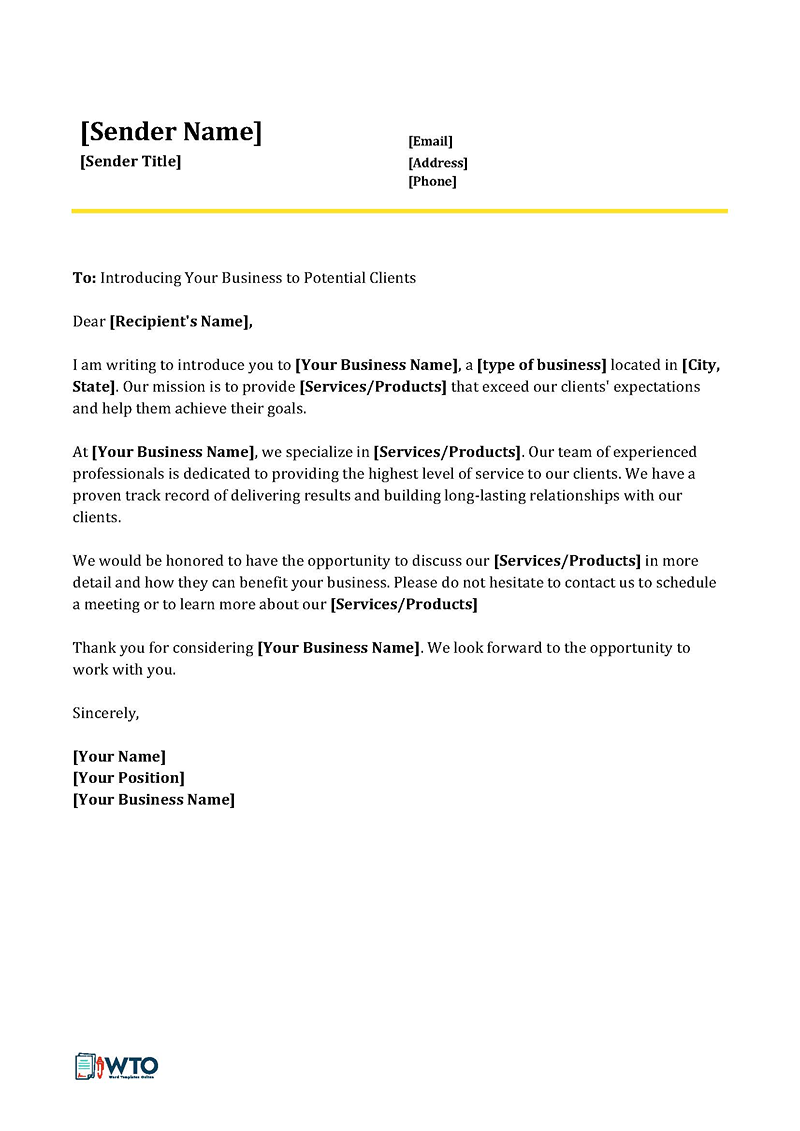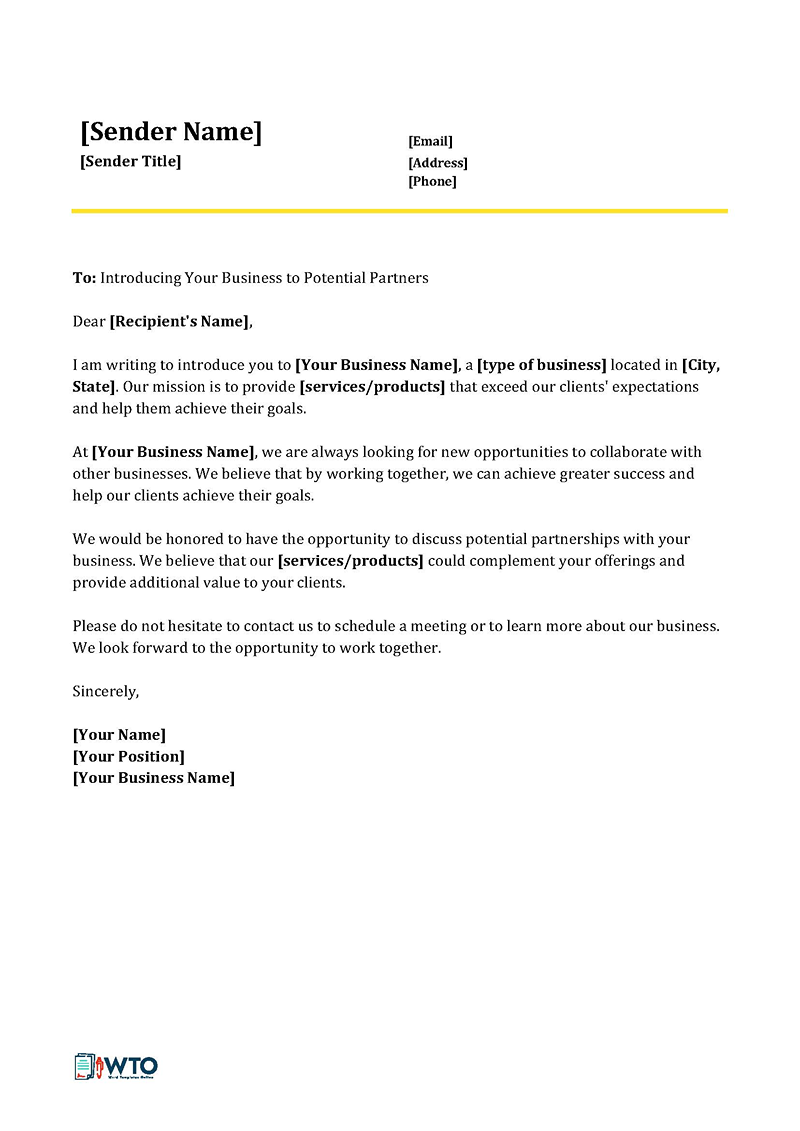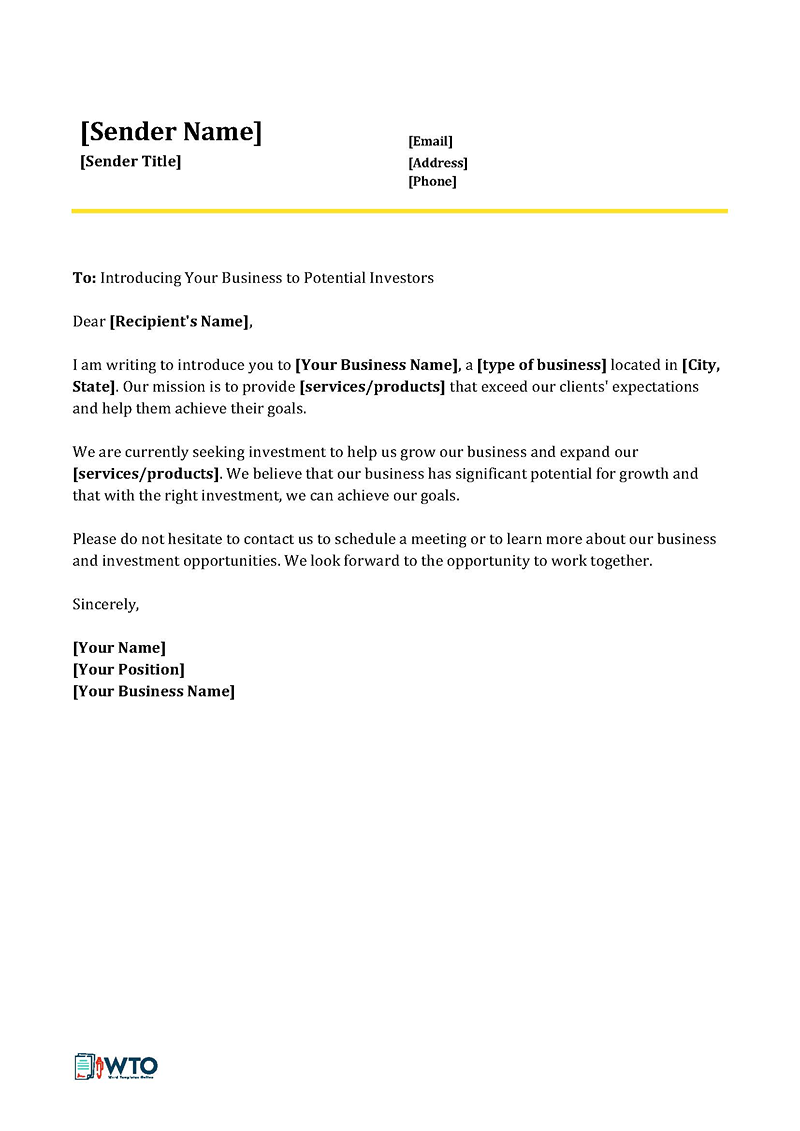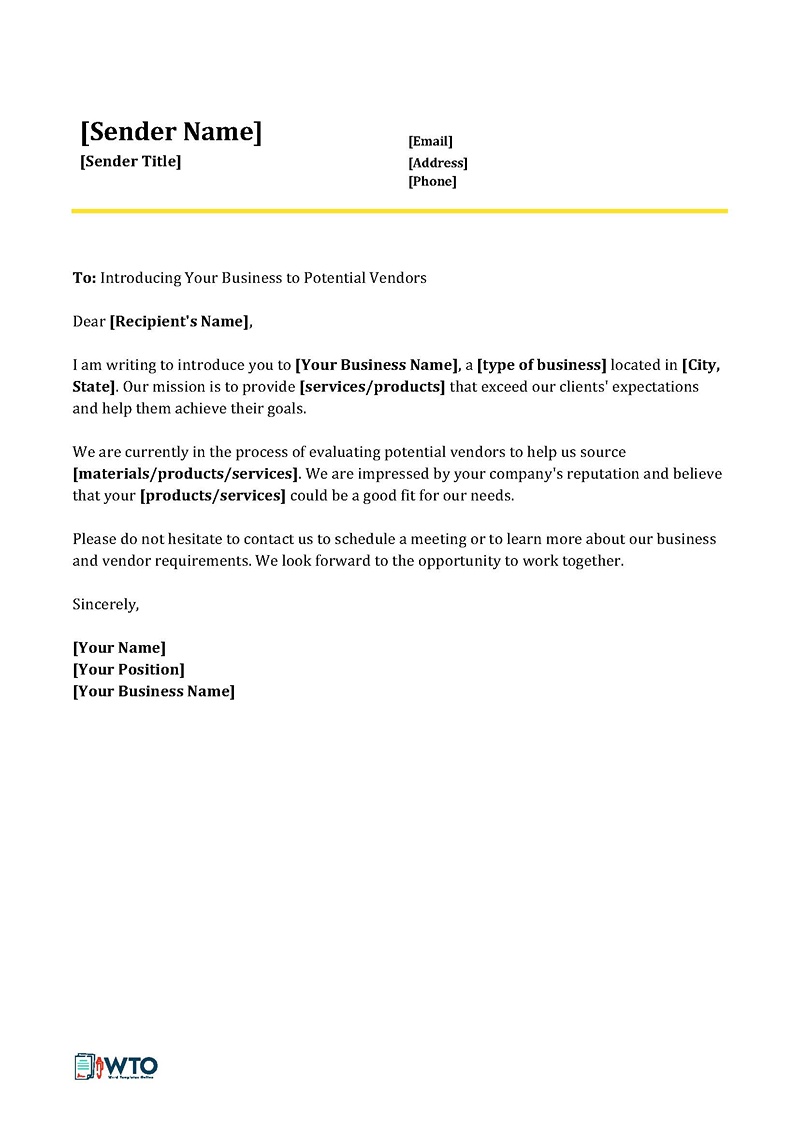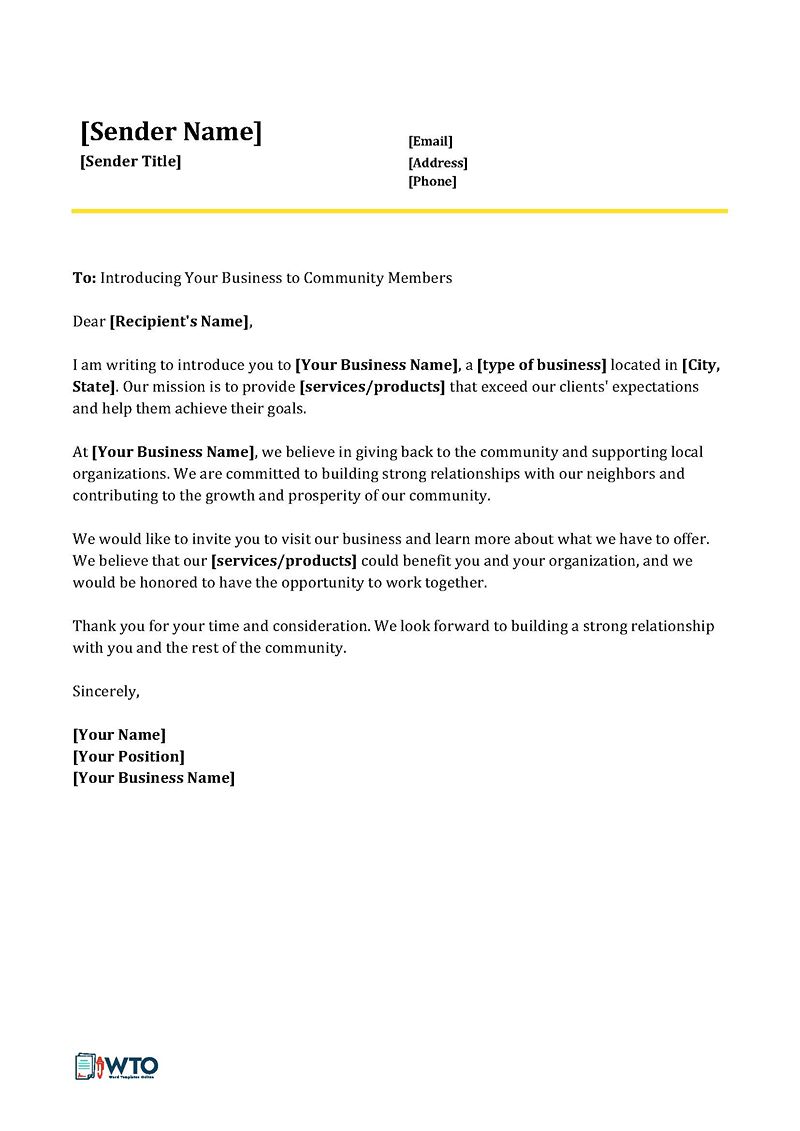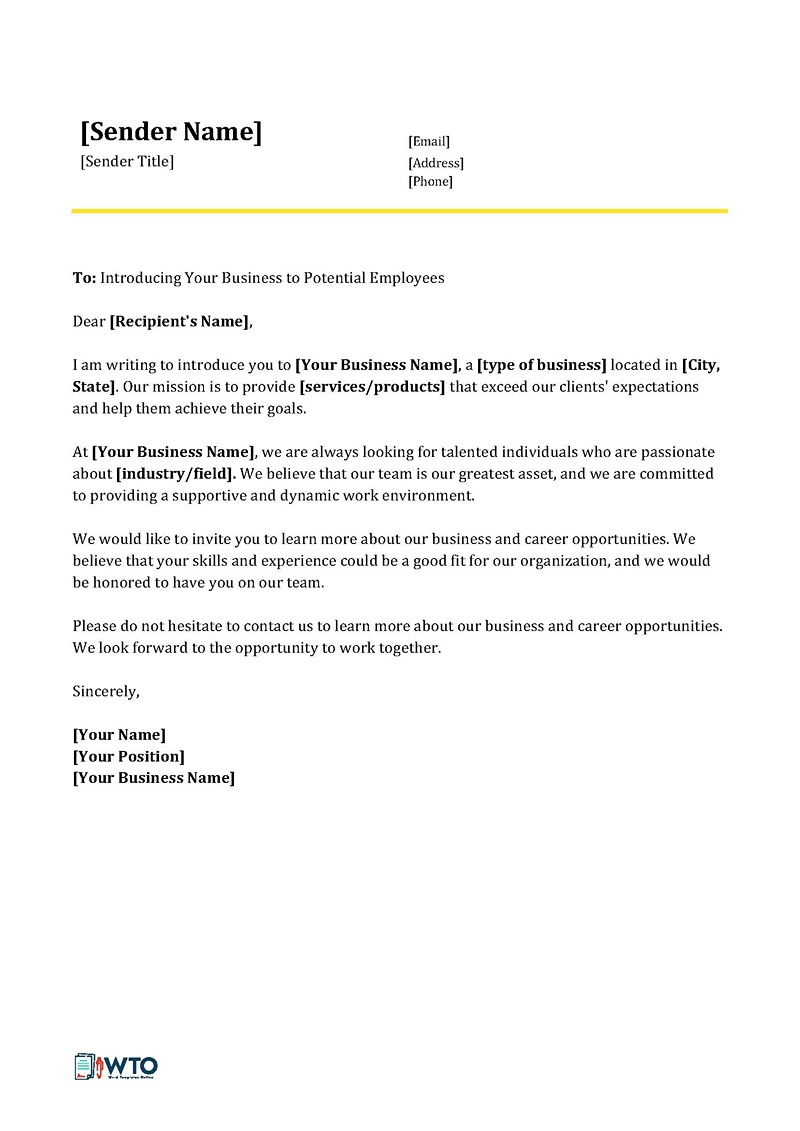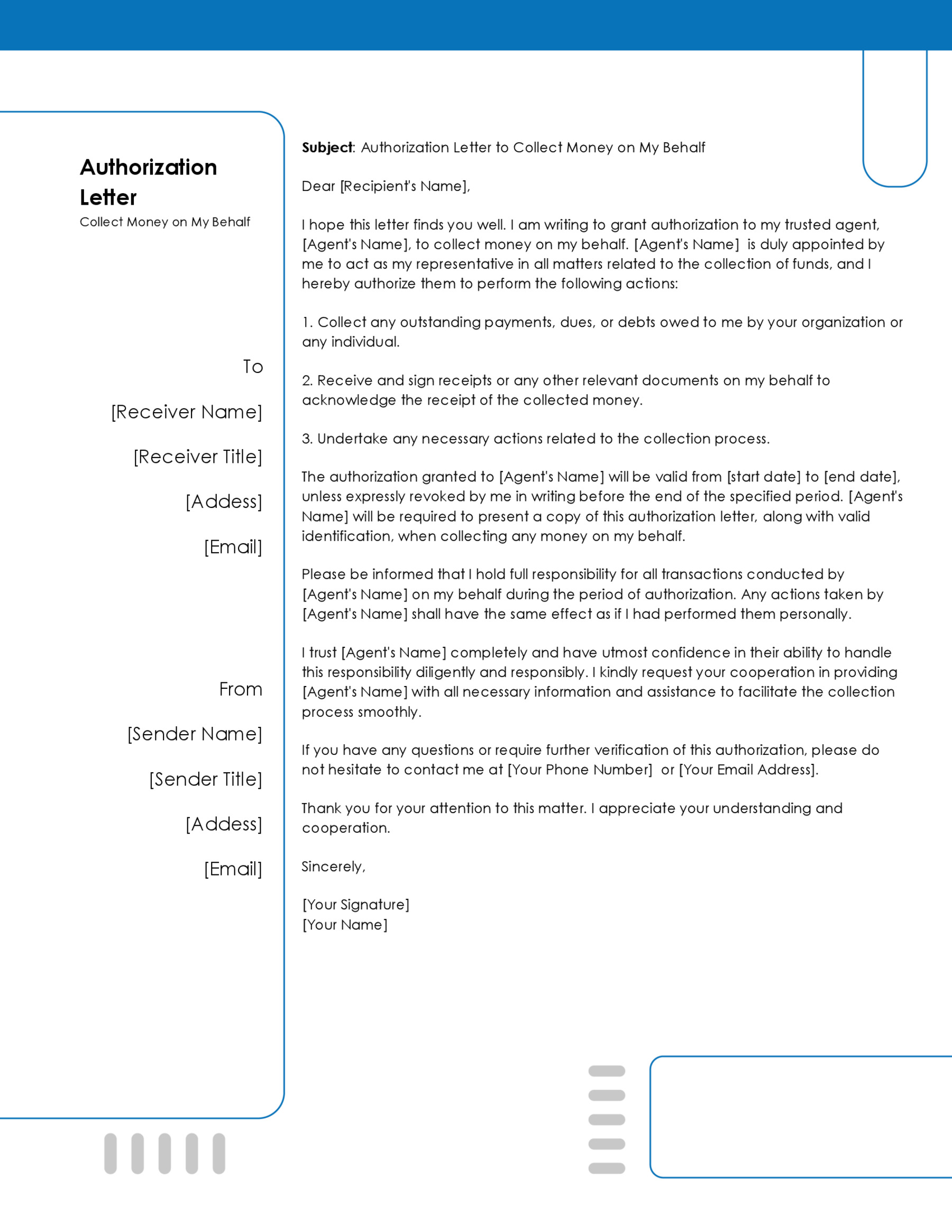When a business is expanding, especially in its early stages, the owners would want to reach out to prospects to initiate a business relationship. The most effective way to achieve this would be through an introduction letter. Such letters should be friendly and positive, with the hope of further correspondence. It is typically sent by new businesses to other business owners within the local area or to potential clients made while networking.
While writing it, you should make sure that you create a good first impression for your business. But how does one achieve this? There are several components to include in such a letter. This article will guide you on how to write it. We have also provided free samples that you can use as a reference and templates that you can customize to meet your specific requirements.
Business Introduction Letter Templates
Business Introduction Letter
A letter to introduce your company is written for potential customers, partner businesses, distributors, investors, or other entities. It describes the products or services offered, introduces the business, and explains why the recipient might be interested in the company’s offerings.
These letters may be categorized as either business-to-business or business-to-customer:
Business-to-business letter
It is sent when a company writes to another business to introduce its products, services, or intent. The reason behind writing this letter is usually to describe a possible partnership, request investment opportunities, or introduce the type of products and services that a company offers if the company’s specialization is another type of business.
Business-to-customer letter
It is written to a company’s clients. It is used to introduce a sale, new products into the market, discounted services, or to notify a given market of a new company’s arrival. Either type of letter has to be written in a formal format, but that does not mean that it should not be friendly.
The Importance of Well-Written Business Letter
Most people continue to overlook the impact of traditional letters as electronic communication has grown in popularity over the last few years. But such letters are still important in official communication.
The following are some of the reasons why it is important to write a letter properly:
- A well-written document with a great sales pitch and introduction on letterhead can build a more personal connection with a prospective client, thus creating a robust business relationship between the client and the business. Such a letter can deliver the message better than an email, which would probably join the clutter of messages in the client’s inbox.
- When a letter is properly formatted, it conveys a sense of professionalism to your clients, especially if it is typed and printed on quality paper and folded neatly. Even before the recipient reads the letter, this shows them that you took the time to carefully write it, which increases their trust in your brand and the services and goods you provide.
- A clearly written letter shows that the content is presented in a coherent and logical manner. This means that the message conveyed in the letter is clear and free from doubt for your clients, unlike one that is poorly written.
Format of Introduction Letter
The format of this letter varies depending on your target audience and may take different forms.
Consider using the formal letter format, which comprises the following elements:
- Margins: Any formal letter should have half-inch to 1-inch margins on the top, bottom, and sides.
- Line spacing: While writing your letter, consider using single-line spacing. In addition to that, always leave a single space before writing another paragraph to make your work look neat and well-presented.
- Alignment: It is a great idea to use a semi-block format where your contact information and salutation are aligned to the left while others, like the closing statement, are aligned to the right. Equally, you may decide to align all of the text to the left.
- Font: The font size for the text should be no smaller than 10-point font and no larger than 12.
- Sender’s details: Ideally, you might want to have a printed company letterhead to portray that your business is legit. However, if you do not have one yet, type your contact information at the topmost part of the letter, including your name, address, and contact information. The address must be included because you do not want the recipient of your letter to have to look up your address before sending a response.
- The date: Dating the letter is very important because the recipient needs to know when it was written. For this reason, it would be best if you date your letter using the standard United States format. For instance, February 24, 2021
- Receiver’s address: It is important to include the recipient’s address right below the date so that you have the information readily available for printing out the envelope. Similarly, typing the recipient’s address ensures that the letter is not lost in the office shuffle anytime you are sending it out. While writing the recipient’s address, the first line should be the recipient’s name, followed by the designation, and the company’s name, in that order. The address, city, state, and zip code should appear in the fourth line.
- The salutation: This is your greeting. It should be professional. You must address your reader by name if you are writing this letter. It is worth noting that using a colon (:), not a comma (,) after the salutation denotes it is business correspondence.
- The body paragraph: Typically, it comprises three paragraphs. The first paragraph introduces yourself and your business and provides your reason for writing the letter. The middle paragraph includes the details of your business and the services or products that your business offers. The final paragraph concludes your letter by restating your purpose and providing a call to action. Nevertheless, your letter may take four paragraphs based on the type of information you are providing, but you should stay professional, clear, and concise and quickly convey the letter’s message because time is money.
- Closing: It is always good to conclude your letter with a formal but friendly statement. Closing statements such as “Sincerely” or “Thank you” are better options.
Writing a Business Introduction Letter
Before you embark on writing it, it is a great idea to prepare an outline of what you want your letter to look like. This way, you will find it quite simple to draft the letter.
You can follow the following easy steps to help you write a well-drafted letter of introduction for your business:
Determine the Intent
Determining the intent of your letter is the first step in writing a good one. If, for instance, you recently launched a new business and you want your consumers to know about your products and services, you can write a business-to-customer letter. If you aim to establish ties with another business, you can write a letter of introduction.
By identifying the intent of the letter before actually starting to write it, you are better positioned to determine the type of information to include in the letter before sending it, and it also ensures that you have included all the relevant information.
Research the company or market
After determining the intent of your letter, the next step should involve researching the company you intend to communicate with, its brand and identity, market, and products or services. Similarly, if you are writing a letter to expand your client base, it is best for you to research popular products or services that compete with your business and how you can provide information that will convince these clients to buy from you instead.
Researching the company or target market allows you to find out what the target audience wants in terms of tastes and preferences and enables you to write this letter that covers precisely what interests them the most.
Identify a need
Once you have done your research on your target audience, it is easier for you to establish their needs. For instance, if your audience is another business, you might identify that the business needs your services. If your target audience is clients, you might find out that they need the products your company manufactures. Establishing your target audience’s needs helps you to provide the most relevant information about your business.
Write a compelling introduction
After you have conducted your research and identified a need, it is time to write the letter. Begin it with a robust opening statement, for example, using your business’s slogan or a remarkable quote. By doing this, you can capture the recipient’s attention and interest in wanting to learn more about your business. This ensures that they read your entire letter.
Include all the relevant information
Based on your letter’s intent and your target market, provide all the relevant details that are suitable for them. Suppose you are writing it to seek a partnership with another business; your relevant details would be the type of products and services you intend to offer in a partnership setting and the partnership parameters.
If you are writing a letter to launch a new business into the market, you might only include information such as how your products or services will help improve the lives of your clientele.
Include a call-to-action plan
Include a call to action right before you end your letter. This means that you should describe how the recipient can contact you or what further actions the recipient may take to get more information about your business. Providing a call to action motivates your recipient to engage with you or to continue communicating with your business.
Closing
Sign off the letter using a closing statement that is professional and conveys positivity after the call to action statement. Consider using statements like “warmest wishes,” “best regards,” and “kindest regards,” among others.
template
[Your Company Letterhead]
[Your Name]
[Your Title/Position]
[Company Name]
[Company Address]
[City, State, Zip Code]
[Email Address]
[Phone Number]
[Date]
[Recipient’s Name]
[Recipient’s Title/Position]
[Recipient’s Company/Organization Name]
[Company Address]
[City, State, Zip Code]
Dear [Recipient’s Name],
I hope this letter finds you well. My name is [Your Name], and I am the [Your Title/Position] at [Your Company Name], a company specializing in [briefly describe your company’s area of expertise or main business activity]. I am reaching out to introduce our company and to express our interest in exploring potential collaboration opportunities with [Recipient’s Company/Organization Name].
[Your Company Name] was established in [Year of Establishment], with a mission to [briefly describe your company’s mission or objective]. Over the years, we have grown to become a leader in our industry, known for [mention any notable achievements, awards, or unique selling propositions]. Our team is dedicated to [briefly describe what your company does or offers, focusing on the benefits to clients or partners].
We have taken the liberty of researching [Recipient’s Company/Organization Name] and believe that there could be a synergistic relationship between our two companies. Specifically, we are interested in [mention any specific areas of potential collaboration, such as joint ventures, supply opportunities, service offerings, etc.].
Enclosed with this letter, you will find [mention any enclosed documents, such as brochures, product samples, case studies, or business cards]. These materials will provide you with a more comprehensive understanding of what we do and how we can potentially work together.
I would be delighted to arrange a meeting or a call at your earliest convenience to discuss this further. Please feel free to contact me directly at [Your Phone Number] or via email at [Your Email Address]. I am looking forward to the opportunity to speak with you and to explore ways in which [Your Company Name] and [Recipient’s Company/Organization Name] can form a mutually beneficial partnership.
Thank you for considering this introduction. I hope to hear from you soon.
Warm regards,
[Your Signature (if sending a hard copy)]
[Your Typed Name]
[Your Title/Position]
[Your Company Name]
[Contact Information]
Samples and Examples
Sample 1
Dear Ms. Smith,
I hope this letter finds you in good health and high spirits. My name is John Doe, and I am the CEO of Innovatech Solutions LLC, a dynamic startup specializing in cutting-edge blockchain technology solutions. We are reaching out to introduce our company and to explore potential collaboration opportunities with Global Enterprises Inc.
Founded in 2023, Innovatech Solutions LLC is on a mission to revolutionize the way businesses operate by leveraging the power of blockchain. Our team has developed a range of products designed to enhance security, transparency, and efficiency in business operations. Notably, our flagship product, BlockSecure, has been recognized for its innovative approach to supply chain management.
We have taken the time to understand the challenges and needs of Global Enterprises Inc., particularly in enhancing operational efficiency and security. We believe that our blockchain solutions can offer significant value to your company, especially in areas such as supply chain management and data security.
Enclosed with this letter, you will find a brochure detailing our products and services, along with case studies demonstrating their impact on businesses similar to yours. We are confident that this information will provide a clear picture of the potential benefits of our collaboration.
I would be delighted to arrange a meeting or a call at your earliest convenience to discuss how Innovatech Solutions LLC can contribute to the success of Global Enterprises Inc. Please feel free to contact me directly at (555) 123-4567 or via email at john.doe@innovatechsolutions.com.
Thank you for considering this introduction. I am looking forward to the opportunity to discuss our potential collaboration further.
Warm regards,
John Doe
CEO, Innovatech Solutions LLC
john.doe@innovatechsolutions.com
(555) 123-4567
Sample 2
Dear Mr. Lee,
Greetings! My name is Alice Johnson, and I am the Founder and Creative Director at Creative Minds Marketing Agency. We specialize in providing innovative marketing solutions tailored to startups and small businesses looking to make a significant impact in their industry. I am writing to introduce our agency and to express our interest in partnering with Fresh Startups Inc.
Since our inception in 20XX, Creative Minds has been at the forefront of digital marketing innovation, helping our clients achieve remarkable growth and visibility in competitive markets. Our services range from SEO and content marketing to social media strategy and brand development. We pride ourselves on our ability to understand and adapt to our clients’ unique needs, ensuring personalized and effective marketing campaigns.
We are aware of the challenges that startups face in establishing a strong market presence and believe that our expertise in strategic marketing can be instrumental in propelling Fresh Startups Inc. to new heights. Our approach is not just about increasing visibility but building a lasting brand that resonates with your target audience.
Please find enclosed a portfolio of our recent work, which showcases the breadth and depth of our capabilities. We are keen to demonstrate how our creative and strategic services can complement the innovative products and services offered by Fresh Startups Inc.
I would be thrilled to discuss this further and explore how we can collaborate to achieve your marketing goals. I am available for a meeting or a call at your convenience. You can reach me at (512) 987-6543 or via email at alice.johnson@creativemindsagency.com.
Thank you for considering Creative Minds Marketing Agency. I am eager to hear from you soon and hopefully embark on a successful partnership.
Best regards,
Alice Johnson
Founder & Creative Director
Creative Minds Marketing Agency
alice.johnson@creativemindsagency.com
(512) 987-6543
Analysis
These letters are effective examples of business introductions due to their concise and professional structure, which fosters potential collaborations. Each begins with a warm greeting and a succinct introduction of the sender’s company, setting a friendly yet professional tone. They effectively highlight the company’s core business and expertise, clearly demonstrating how their services could benefit the recipient. This is achieved through specific examples, such as notable achievements or a range of services offered, establishing credibility and relevance.
The inclusion of a call to action, proposing a next step like a meeting or call, is crucial for advancing the dialogue towards collaboration. It encourages the recipient to engage further, moving beyond the introductory letter to actual business discussions.
Concluding with thanks and reiterating interest in collaboration, while providing contact information, the letters maintain professionalism and openness for future interactions. This approach not only exemplifies effective communication but also lays the groundwork for building potentially fruitful business relationships. Each element of these letters—from introduction to conclusion—works together to create a compelling case for partnership, demonstrating the sender’s readiness to contribute value and engage in mutual growth opportunities.
Introduction Letter Examples
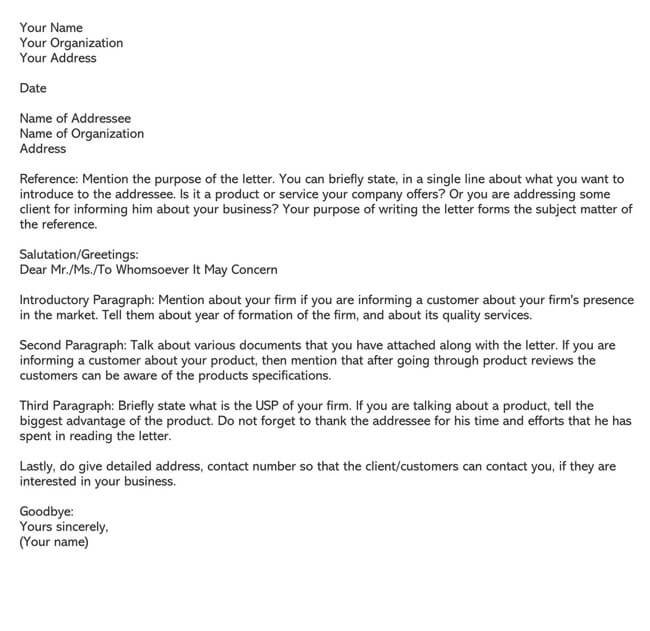
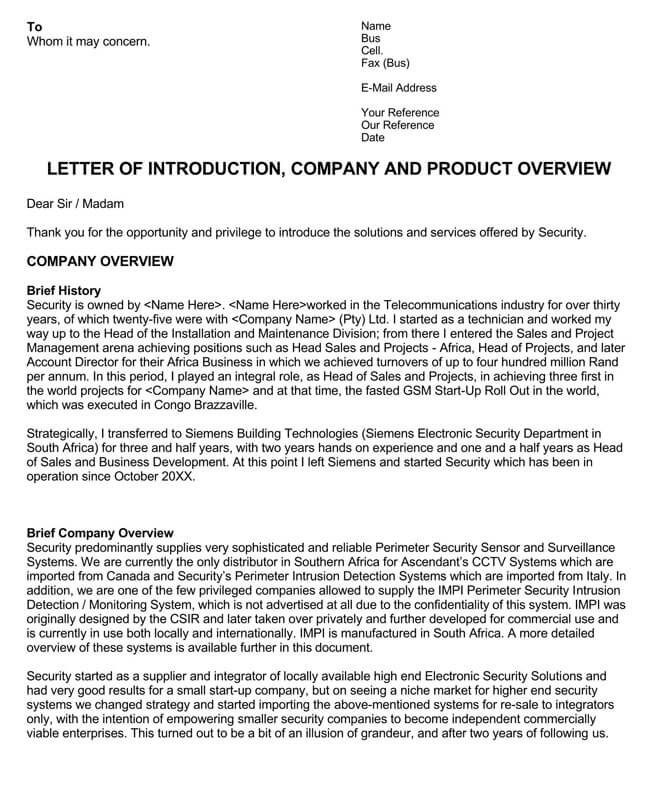
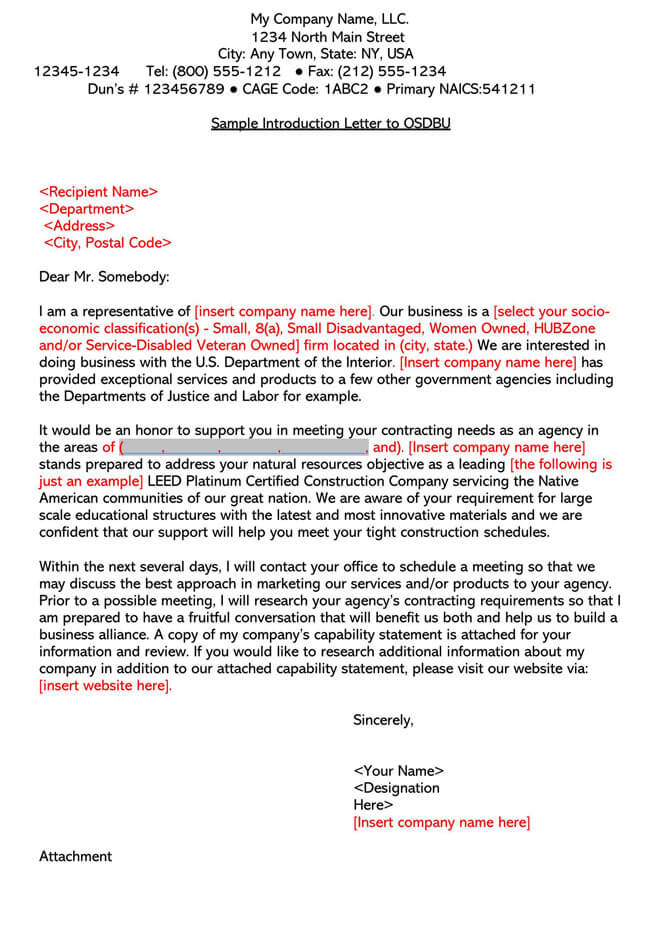
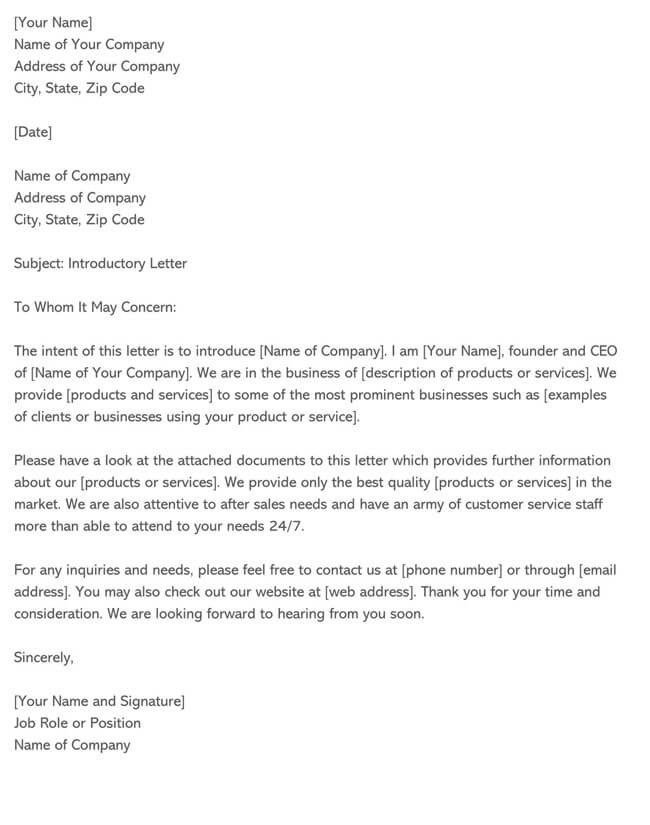
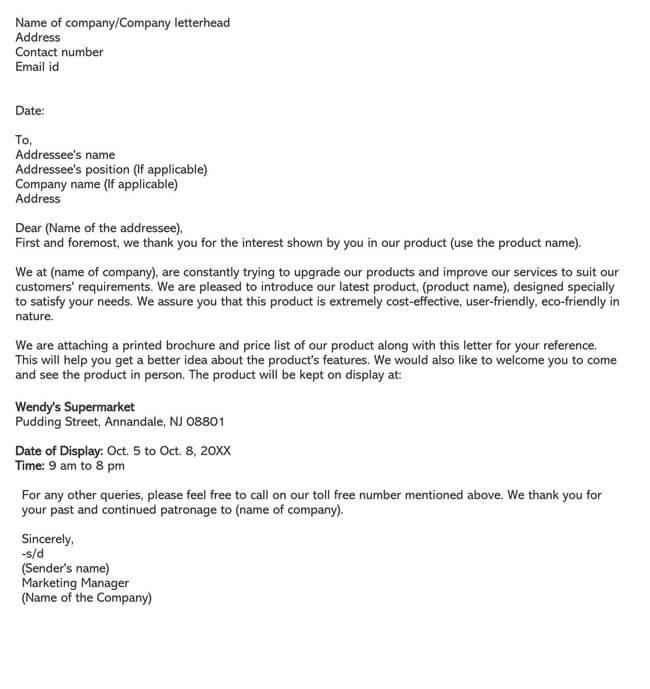
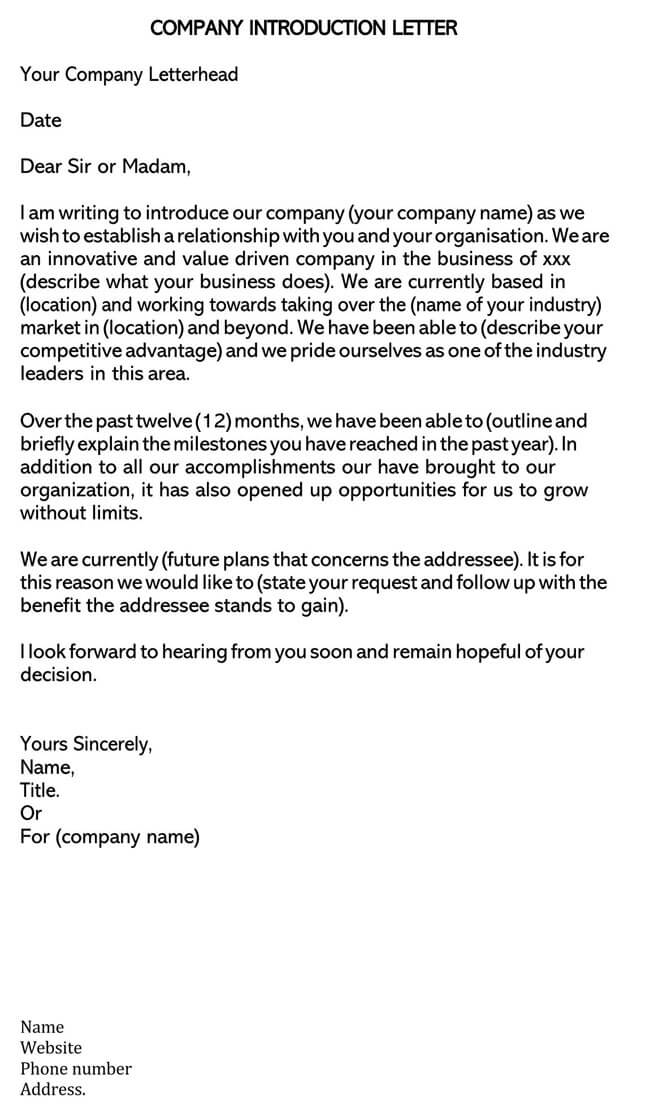
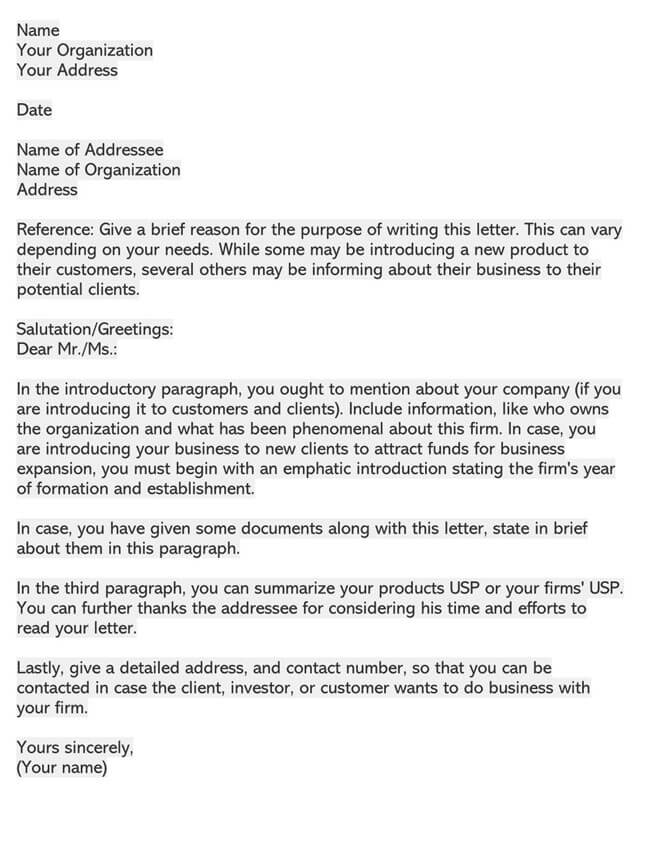
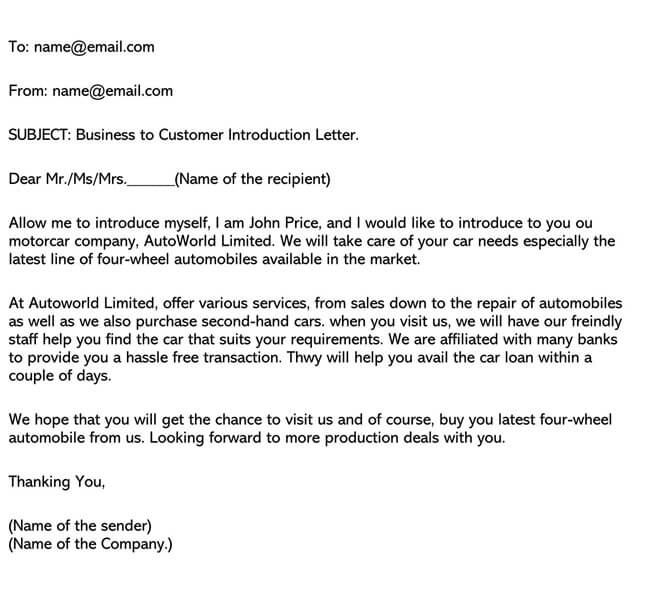
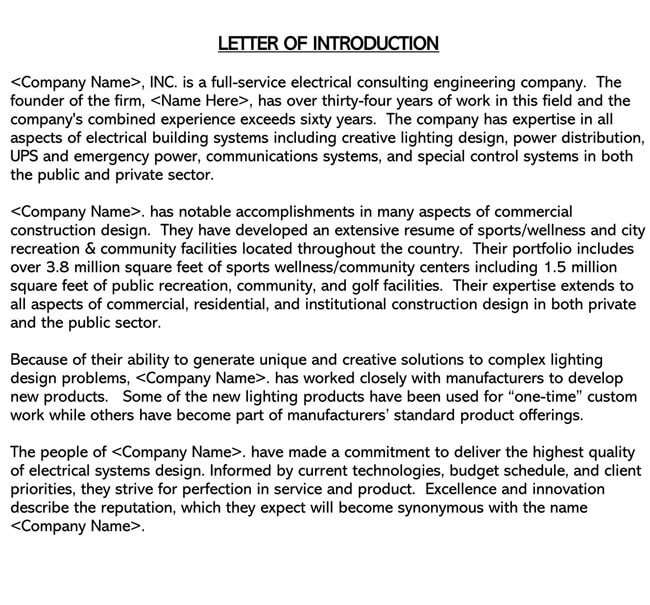
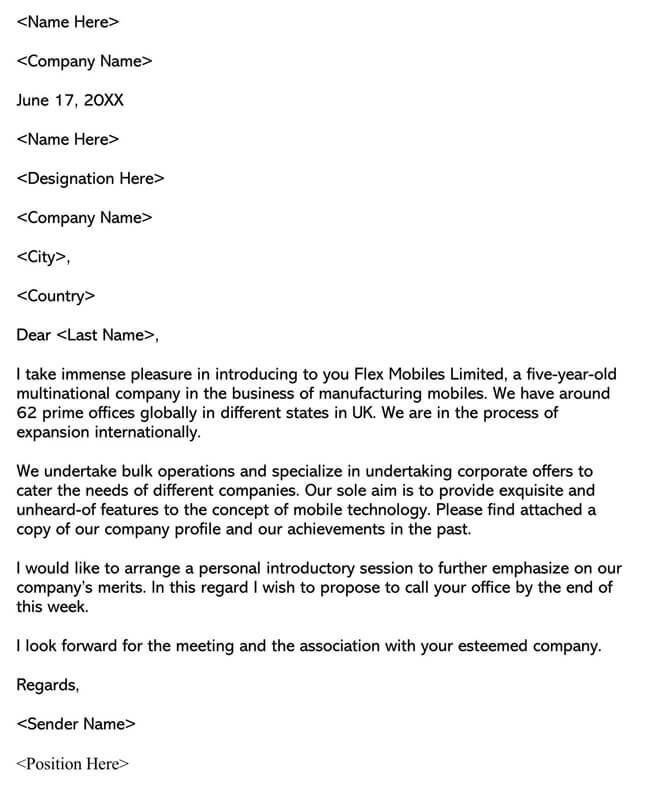
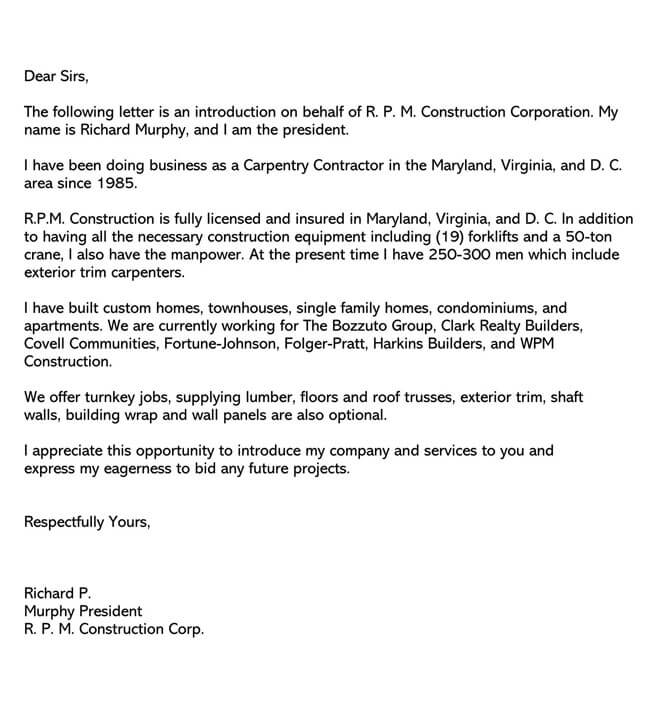
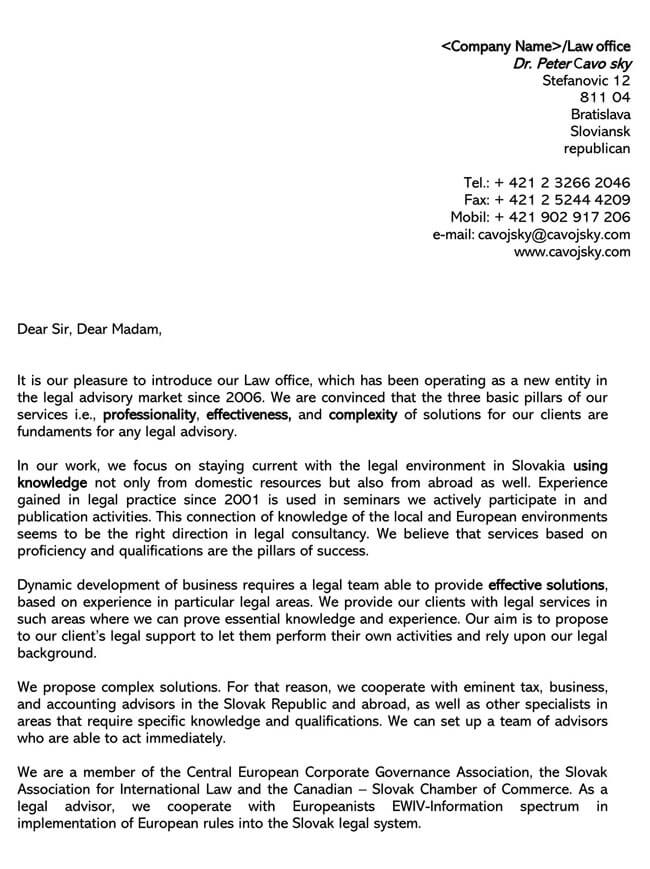
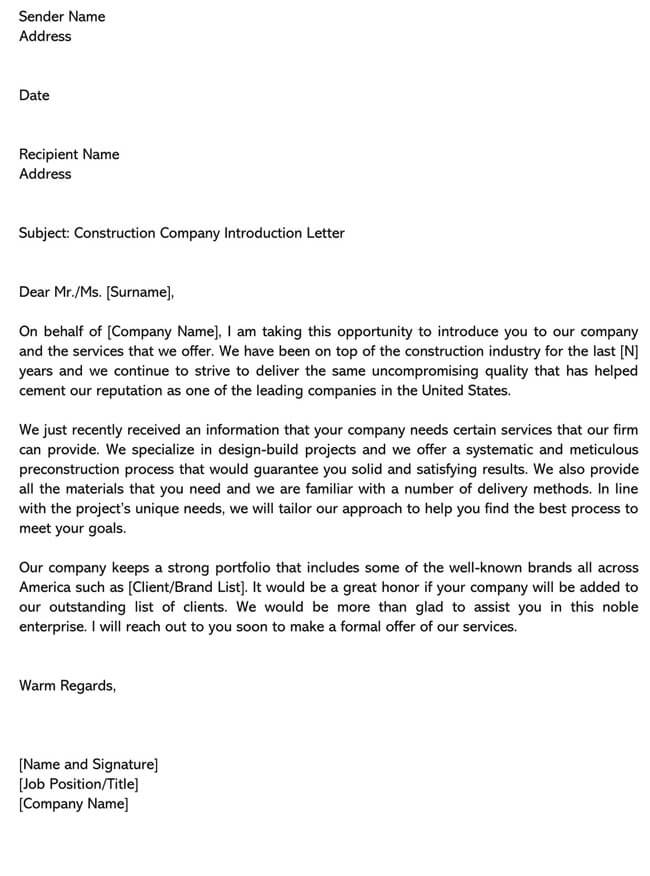
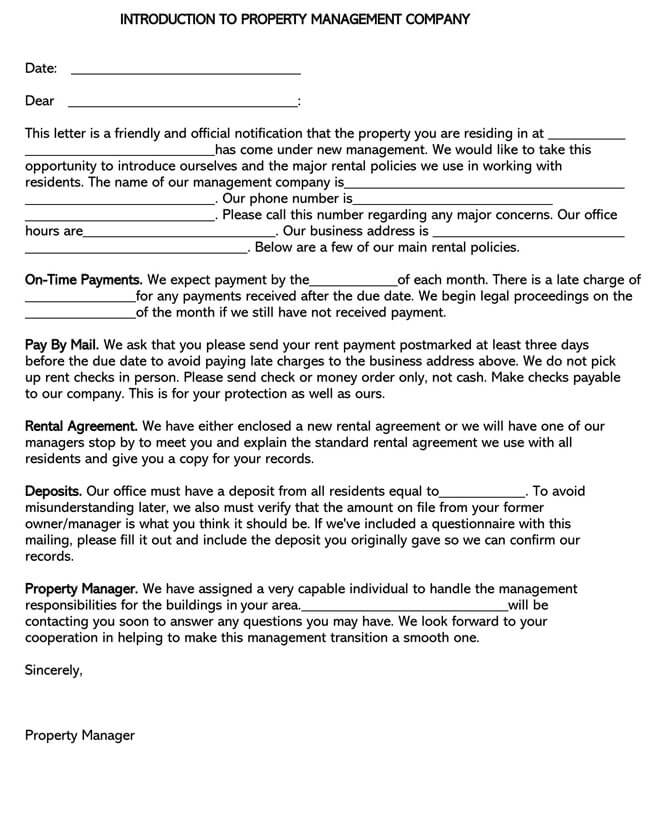
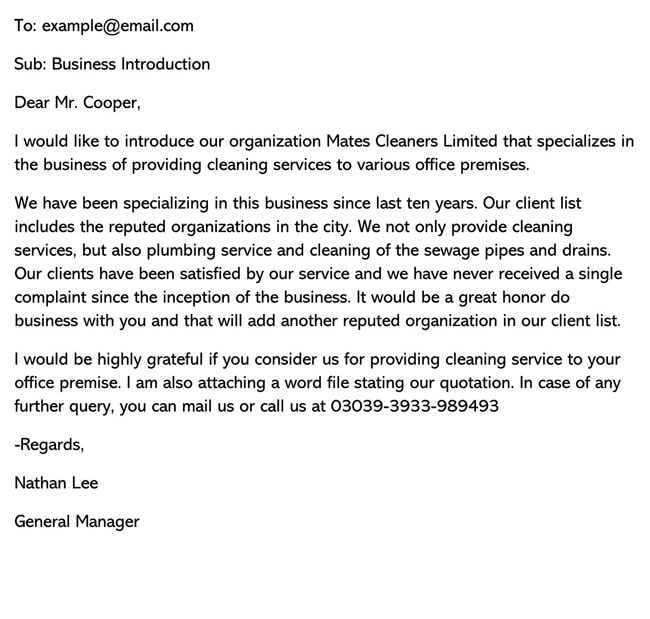
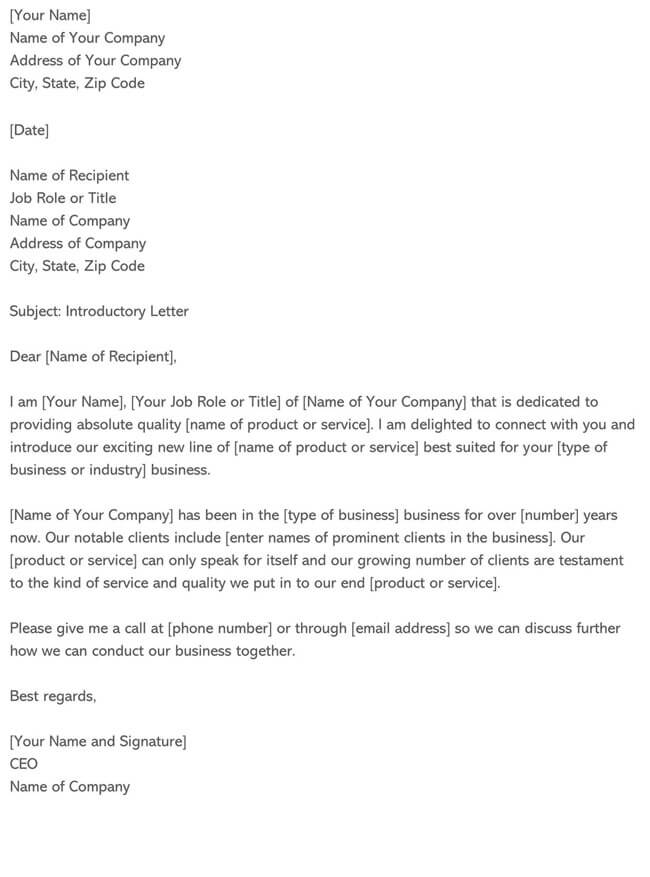
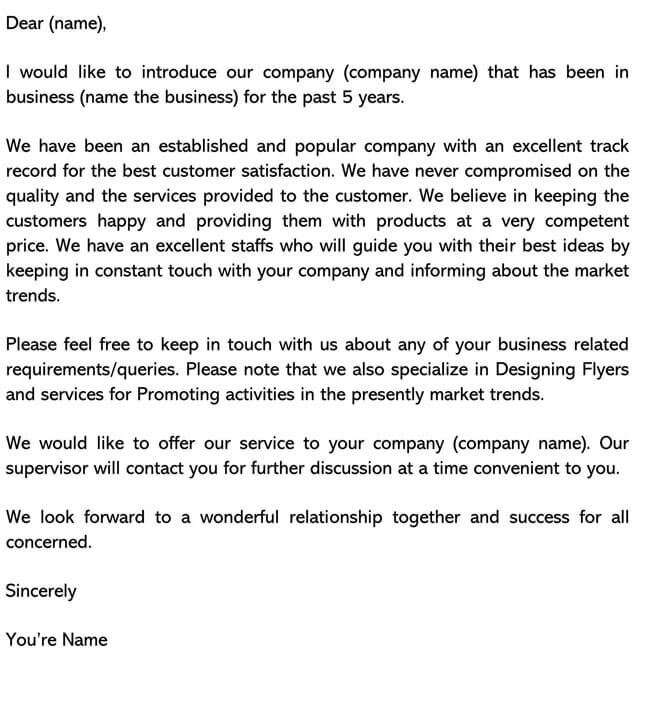
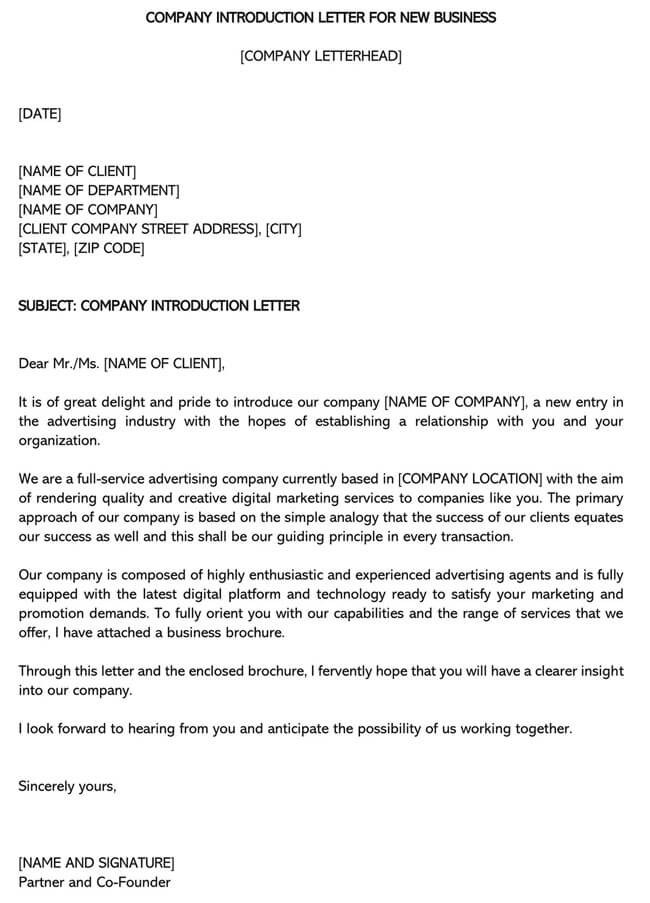
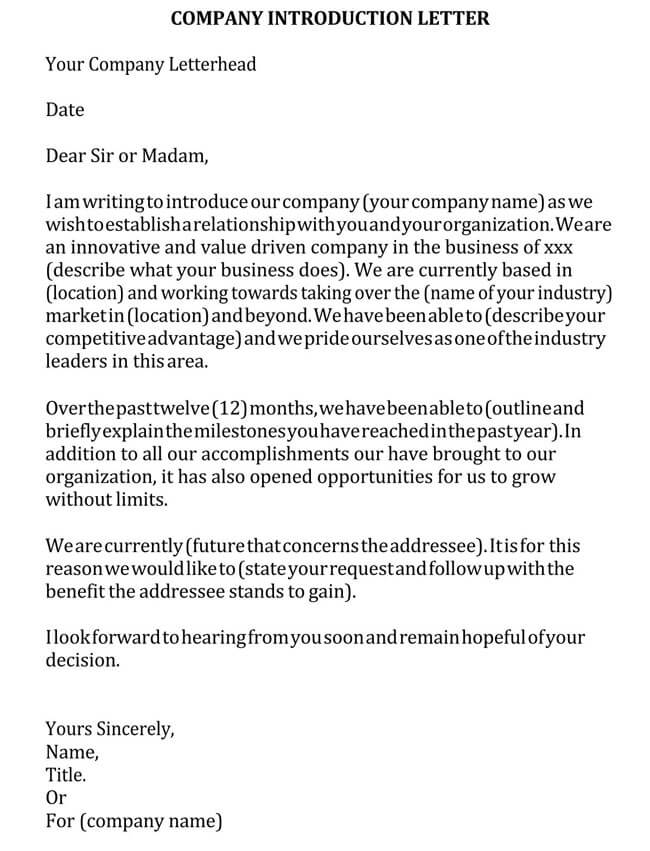
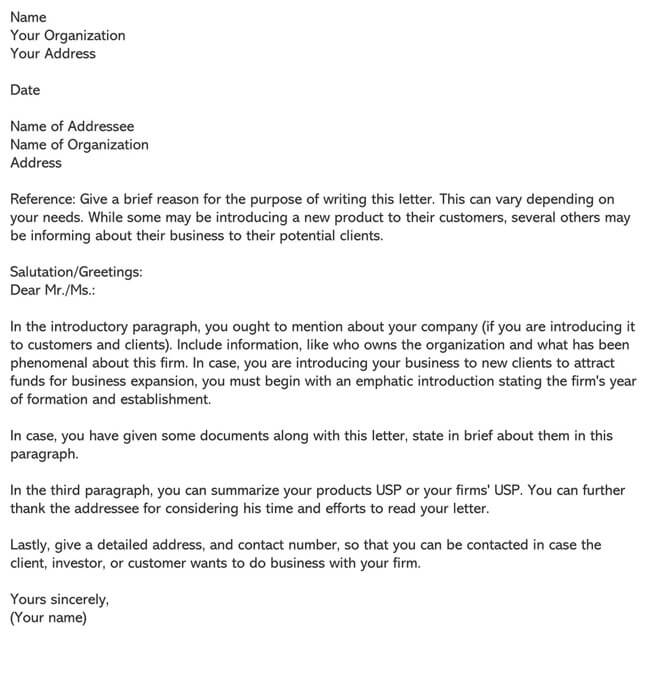
Professional Tips
Whether you have just started a business or you want to expand your customer base, this letter is necessary whenever you are trying to communicate with your prospects.
While writing it, you might want to consider the following tips and tricks:
Be informal but not distant
Although it is important to remain formal since it is an official letter, it is good to use a friendly tone. If you have been in business for some time, you probably realize that business is all about fostering the right kind of relationship with clients and connecting with people. Being friendly makes the recipient more inclined to explore your products or services, and this is certainly good for you and your business.
Build a connection
Introduce yourself by mentioning something common, such as a business event that you both attended, a mutual friend, or the fact that you legitimately have a service they might be interested in.
Provide accurate contact details
You must also provide your contact information. You would not want the recipient to call you, inquire about the details, and establish further contact with your company. Therefore, you must provide all your contact information accurately.
Explain what you can do or provide
The main points of the deal you have in mind should be included in a good letter introducing your company. Recipients want to know how they will benefit from your business. Therefore, explain well in the letter what you intend to do or provide.
Be brief and concise
Time is of great importance to most people, and this includes your target audience. Therefore, your letter should not be unnecessarily long. It would be best if you kept it between 300 and 400 words. To accomplish this, just include the necessary details that you would want the reader to know about your business. Avoid being overly wordy or providing details that obscure your intent.
Review and proofread
Before sending your letter, make sure to review it and proofread to check for any typing mistakes, spelling errors, and grammar errors. Additionally, ensure that your recipient’s name is written correctly. Also, the letter should be formatted correctly.
Sign your letter by hand
To personalize your letter, you might want to sign it by hand to make a great first impression.
Frequently Asked Questions
The recipients of the letter are probably busy professionals. They want to quickly read the letter and understand your point right away. For this reason, you should keep your letter to a single- page, using short sentences and short paragraphs. Preferably, it should be 300 to 400 words long.
Yes. If you have the recipient’s email address, then you can send your letter via email. In any case, emails are a faster means of business correspondence compared to mailings.
Conclusion
Writing a good letter to introduce your company is a better strategy for forging new connections with your business prospects. They help you introduce yourself to a potential new client, another company, distributors, investors, or other individuals to describe the products or services that you offer. Mastering the art of writing a great letter is essential, as it is an effective way you can create and maintain business relationships as your company grows and expands into new territories.
